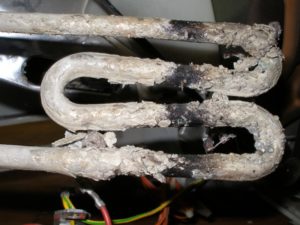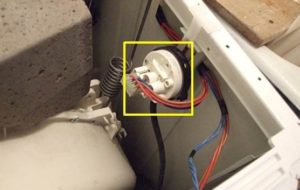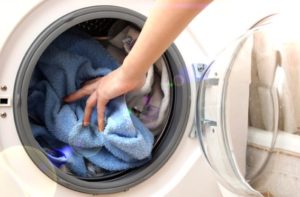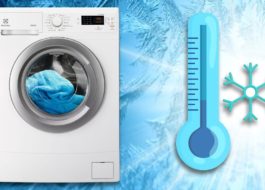Bosch washing machine does not heat water - what to do
 The craftsmen shrug their shoulders in bewilderment, not understanding why many users seek to change the heating element when the washing machine stops heating the water. Lack of heating can be the result of a variety of breakdowns, and today we will try to describe them. If you are faced with the fact that your Bosch washing machine does not heat the water, do not rush to jump to conclusions. First you need to check everything carefully, which is what we will do now.
The craftsmen shrug their shoulders in bewilderment, not understanding why many users seek to change the heating element when the washing machine stops heating the water. Lack of heating can be the result of a variety of breakdowns, and today we will try to describe them. If you are faced with the fact that your Bosch washing machine does not heat the water, do not rush to jump to conclusions. First you need to check everything carefully, which is what we will do now.
Causes of failure
No heating when washing? Usually the owner notices such a breakdown almost immediately after it appears. Firstly, the laundry begins to wash much worse, and secondly, condensation appears on the hatch door during washing, which indicates that it is washed from the inside with cold water.
In most cases, the machine continues to operate as normal, despite the lack of heat. But sometimes it stops, giving errors F19 or F22. We have to solve the problem immediately, but how to carry out repairs without the appropriate knowledge and experience? Don’t worry about this, our specialists are always ready to help. Let's first highlight the range of possible faults.
- The heating element has burned out or its circuit has broken.

- The temperature sensor or its circuit has failed.
- The water level sensor is clogged or burned out.
- The control module is faulty, the firmware has crashed.
It is quite difficult even for an experienced technician to determine a specific malfunction based on the external behavior of a Bosch washing machine. An amateur will only be able to detect a breakdown during a classic test. We will now tell you how this is done.
Heating element or its circuit
The heating element of the Bosch washing machine is located on the front, so to get to it, you need to remove the front wall of the case. You can’t just remove the front wall, you must first:
- remove the top cover;
- pull out the powder receptacle;
- unscrew the control panel;
- remove the decorative panel;
- remove the hatch cuff;

You don’t have to completely remove the hatch cuff; just pull off the clamp and tuck the elastic into the drum.
- unscrew the UBL.

To partially disassemble the washing machine, it is enough to get a screwdriver for four- and hex-head bits, and to check we need a multimeter. First of all, we check the resistance of the heating element itself, which is installed in a special socket in the tank. Next we check the power wiring.

In the future, we act based on the results of the check. If the heating element is faulty, it needs to be pulled out and a new original part put in its place. If an open circuit is detected, you need to solder the wire or replace it if it is damaged. More details about the process replacing the heating element in a Bosch washing machine described in the article of the same name, so we deliberately omit the details and move on.

temperature sensor
The temperature sensor does not break down very often, however, it is worth checking it. The reasons for the temperature sensor malfunction lie in overheating of the water, in a manufacturing defect or in a system failure, but, ultimately, the reason is not so important. It is much more important to detect the problem in time and replace the faulty part.
The temperature sensor is installed directly into the heating element seal, which means that, as in the previous case, we will have to partially disassemble the Bosch washing machine to get to this part.
Before disassembling the Bosch washing machine, you must disconnect it from the power supply and turn off the water.
- Take a screwdriver with a T-20 bit and unscrew the screws that hold the top cover of the machine body. Move the lid forward a little and then lift it up.
- Pull the powder receptacle all the way towards you, and then, pressing on the tab in the area of the rinse aid compartment, pull out the powder receptacle.
- There are screws under the dispenser that hold the control panel, they need to be unscrewed. There is another screw on the right at the end of the control panel of the washing machine; this also needs to be unscrewed.

- The control panel now “sits” on latches. With some effort we unclip it and remove it. Be careful not to tear off the wires.
- Open the hatch door completely, bend the cuff at the top with your fingers, and then use a screwdriver to hook the clamp spring. By pulling the spring clamp upward with a screwdriver, you can easily dismantle it.
- We tuck the cuff inside the hatch so that it does not interfere with the removal of the front wall of the machine body.

- Below, under the front wall of the machine, there is a narrow decorative panel. It is attached with latches. Carefully remove the decorative panel, and then unscrew all the screws holding the front wall of the case.
- We unscrew the screws near the UBL, as well as one screw, which is located on top between the front wall of the machine body and the control panel.
- Carefully remove the front wall, while simultaneously disconnecting the UBL power cable.

So, now we have a heating element with a temperature sensor “in full view”, what to do next? And then we remove the wires from the temperature sensor and check its resistance. If the sensor is faulty, unscrew the tension nut, remove the old sensor, and install a new part in its place. If the sensor is intact, you need to check the wiring for a break.
Level sensor
If the water in your Bosch washing machine does not heat up, the water level sensor may be to blame. At first glance, there is no direct connection between the sensor that determines the water level in the washing machine can and the heating of the water, but this is only at first glance. In fact, it is the pressure switch that may be the culprit of this problem.
 The water level sensor is located not far from the heating element, so we will not repeat the partial disassembly of the washing machine. By carefully reading the previous paragraph, you can get to this detail. First of all, you need to check whether the pressure switch tube is clogged.
The water level sensor is located not far from the heating element, so we will not repeat the partial disassembly of the washing machine. By carefully reading the previous paragraph, you can get to this detail. First of all, you need to check whether the pressure switch tube is clogged.
- We climb with our hands between the tank and the side wall of the body of the Bosch washing machine.
- We feel for the tube that goes to the pressure switch and carefully remove it.
- We pull out the tube and inspect it for blockages, and if necessary, bleed it out.
If there is no blockage, you need to check the resistance of the pressure switch coil. A faulty coil cannot be repaired; you will have to remove the wires from the level sensor, remove the broken pressure switch, and install a working part in its place. We check the wiring in the standard way for breakdown.
Control module
After making sure that the heating element, temperature sensor and pressure switch of the Bosch washing machine are in working order, and the wiring is intact, you need to think about problems with the electronics. There is a high probability of a malfunction occurring in the control module.
It is difficult to say what the nature of this malfunction is. The tire may have burned out or the track may have been damaged. Maybe the firmware has simply crashed and needs to be reset. There are many options and the true cause can only be determined through comprehensive professional testing.We strongly recommend that you entrust this work to an experienced technician, because if you damage the control module as a result of a makeshift repair, the cost of replacing it will be enormous.
A relatively inexpensive technician will test the electronic unit of a Bosch washing machine and give his verdict: repair or replacement. Most often, electronic units are subject to repair, so do not get discouraged ahead of time.
How to wash without repair
In the event that you don’t have time to repair a Bosch machine, but you need to wash the accumulated mountain of laundry now, we offer an original way out of the situation. Let’s immediately make a reservation that it is better not to use a faulty machine for a long time and to repair it at the first opportunity. So, how to wash clothes efficiently if the machine refuses to heat the water?
- First, we decide at what temperature we will wash things. We set the specified temperature on the home water heater (for example, 600C) and wait until the water warms up.

- We approach the washing machine and turn off the cold water supply to it. We open the powder receptacle, pour powder into it and insert the shower head into it.
- We put dirty laundry into the drum of the washing machine, close the hatch door, turn on the machine and set the washing program.
- We immediately turn on the hot water, which begins to flow through the shower head into the powder receptacle, washing the powder into the tank of the washing machine.
- We wait until the water fills and observe the behavior of the washing machine. Once there is enough water, the machine will start washing, at this time we must turn off the hot water, Remove the shower head from the tray and push the powder receptacle into place.
- We open the previously shut off cold water tap and you can safely leave the bathroom.Then the washing machine will finish the wash itself, drain the soapy water, pump in rinse water, rinse the laundry, and then spin it. All this will be done without your participation.
As you have already noticed, this method is suitable not only for those who have hot water. If you only have cold water supply in your house, you can heat two buckets of hot water and gradually pour this water through the powder receiver into the washing machine tank. The effect will be exactly the same.
Interesting:
3 reader comments





















“If there is no blockage, you need to check the resistance of the pressure switch coil.”
That's all? Where is the description of the test? What is the coil resistance?
How to check the pressure switch, how does it affect the on/off of the heating element?
The pressure switch basically only has contacts! Yes, there are also electronic ones, but you can’t just check them.